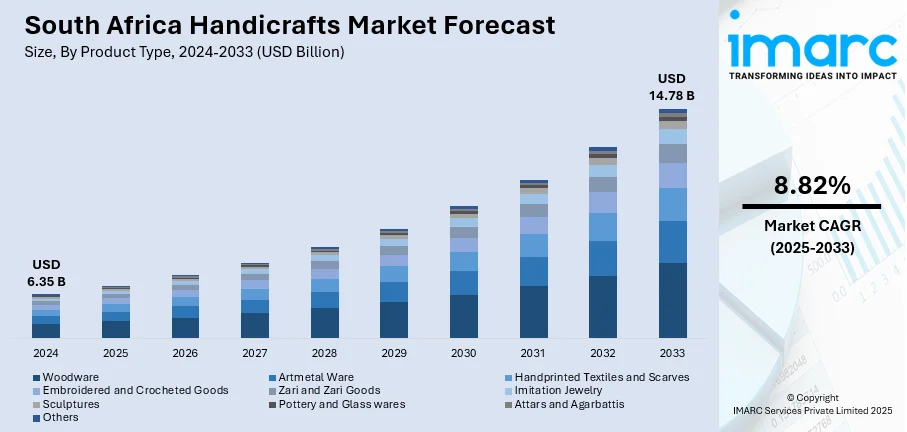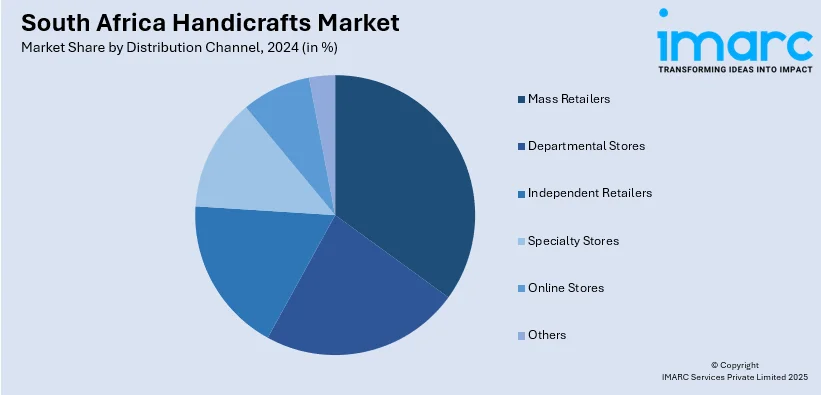
South Africa Handicrafts Market Size, Share, Trends and Forecast by Product Type, Distribution Channel, End Use, and Region, 2025-2033
South Africa Handicrafts Market Overview:
The South Africa handicrafts market size reached USD 6.35 Billion in 2024. Looking forward, the market is projected to reach USD 14.78 Billion by 2033, exhibiting a growth rate (CAGR) of 8.82% during 2025-2033. The market is being driven by factors such as growing tourism, government assistance for local artists, and consumer demand for authentic and culturally rich products. The South Africa handicrafts market share has increased as a result of these reasons as well as the growing demand for eco-friendly and sustainable products.
|
Report Attribute
|
Key Statistics
|
|---|---|
|
Base Year
|
2024
|
|
Forecast Years
|
2025-2033
|
|
Historical Years
|
2019-2024
|
| Market Size in 2024 | USD 6.35 Billion |
| Market Forecast in 2033 | USD 14.78 Billion |
| Market Growth Rate 2025-2033 | 8.82% |
South Africa Handicrafts Market Trends:
Cultural Heritage and Artisan Support
Traditional arts and crafts that showcase the nation's rich cultural legacy are seeing a resurgence in popularity in the South African handicrafts industry. Products that showcase the various cultures, such as Basotho weaving, Xhosa textiles, and Zulu beadwork, are becoming increasingly popular among South African and foreign buyers. This trend is being driven by government programs that support local handicraft and an increasing emphasis on the preservation of indigenous art forms. For instance, as per industry reports, the South African craft sector employs an estimated 1.2 million people and contributes R3.4 billion annually to the economy, providing a primary income source for many poor and rural communities. Additionally, programs supporting artisans with training and access to international markets have bolstered the sector, creating a wider platform for cultural exchange. As such, the South Africa handicrafts market growth is attributed to an increasing preference for products with local craftsmanship, which also appeals to the ethical consumerism trend.

To get more information on this market, Request Sample
Integration of Modern Design with Traditional Techniques
The combination of contemporary design and traditional crafting methods is a prominent trend in the South African handicrafts industry. Customers of today are looking for distinctive goods that combine historical creative traditions with contemporary design. As a result, while preserving traditional workmanship, South African artists are embracing contemporary aspects like geometric patterns, minimalistic designs, and vivid color schemes. This combination produces distinctive products that appeal to both domestic and international consumers. These hybrid designs' popularity has increased market acceptance, especially among younger consumers who value the fusion of the modern and the traditional. This trend has contributed greatly to the South Africa handicrafts market expansion, reinforcing the sector’s relevance in the modern consumer market. For instance, the inclusive arts and crafts design project, led by UCL with SAFOD and UK partners, aimed to empower people with disabilities in Botswana, Malawi, and South Africa through knowledge exchange and heritage-based craft skills. Artists visited London for workshops, exhibitions, and discussions on inclusive crafts. The initiative fostered connections between Southern Africa and the UK, identified shared needs, and explored sustainable markets for artifacts. The project emphasized training, fair pricing, and cultural heritage integration. Follow-on funding was applied to expand SAFOD’s support network of 50,000 members across ten countries, with plans for further initiatives like the Southern Africa Assistive Technology Expo.
South Africa Handicrafts Market Segmentation:
IMARC Group provides an analysis of the key trends in each segment of the market, along with forecasts at the region/province level for 2025-2033. Our report has categorized the market based on product type, distribution channel, and end use.
Product Type Insights:
- Woodware
- Artmetal Ware
- Handprinted Textiles and Scarves
- Embroidered and Crocheted Goods
- Zari and Zari Goods
- Imitation Jewelry
- Sculptures
- Pottery and Glass Wares
- Attars and Agarbattis
- Others
The report has provided a detailed breakup and analysis of the market based on the product type. This includes woodware, artmetal ware, handprinted textiles and scarves, embroidered and crocheted goods, zari and zari goods, imitation jewelry, sculptures, pottery and glass wares, attars and agarbattis, and others.
Distribution Channel Insights:

- Mass Retailers
- Departmental Stores
- Independent Retailers
- Specialty Stores
- Online Stores
- Others
A detailed breakup and analysis of the market based on the distribution channel have also been provided in the report. This includes mass retailers, departmental stores, independent retailers, specialty stores, online stores, and others.
End Use Insights:
- Residential
- Commercial
The report has provided a detailed breakup and analysis of the market based on the end use. This includes residential and commercial.
Regional Insights:
- Gauteng
- KwaZulu-Natal
- Western Cape
- Mpumalanga
- Eastern Cape
- Others
The report has also provided a comprehensive analysis of all the major provinces, which include Gauteng, KwaZulu-Natal, Western Cape, Mpumalanga, Eastern Cape, and others.
Competitive Landscape:
The market research report has also provided a comprehensive analysis of the competitive landscape. Competitive analysis such as market structure, key player positioning, top winning strategies, competitive dashboard, and company evaluation quadrant has been covered in the report. Also, detailed profiles of all major companies have been provided.
South Africa Handicrafts Market Report Coverage:
| Report Features | Details |
|---|---|
| Base Year of the Analysis | 2024 |
| Historical Period | 2019-2024 |
| Forecast Period | 2025-2033 |
| Units | Billion USD |
| Scope of the Report |
Exploration of Historical Trends and Market Outlook, Industry Catalysts and Challenges, Segment-Wise Historical and Future Market Assessment:
|
| Product Types Covered | Woodware, Artmetal Ware, Handprinted Textiles and Scarves, Embroidered and Crocheted Goods, Zari and Zari Goods, Imitation Jewelry, Sculptures, Pottery and Glass Wares, Attars and Agarbattis, Others |
| Distribution Channels Covered | Mass Retailers, Departmental Stores, Independent Retailers, Specialty Stores, Online Stores, Others |
| End Uses Covered | Residential, Commercial |
| Regions Covered | Gauteng, KwaZulu-Natal, Western Cape, Mpumalanga, Eastern Cape, Others |
| Customization Scope | 10% Free Customization |
| Post-Sale Analyst Support | 10-12 Weeks |
| Delivery Format | PDF and Excel through Email (We can also provide the editable version of the report in PPT/Word format on special request) |
Key Questions Answered in This Report:
- How has the South Africa handicrafts market performed so far and how will it perform in the coming years?
- What is the breakup of the South Africa handicrafts market on the basis of product type?
- What is the breakup of the South Africa handicrafts market on the basis of distribution channel?
- What is the breakup of the South Africa handicrafts market on the basis of end use?
- What is the breakup of the South Africa handicrafts market on the basis of region?
- What are the various stages in the value chain of the South Africa handicrafts market?
- What are the key driving factors and challenges in the South Africa handicrafts market?
- What is the structure of the South Africa handicrafts market and who are the key players?
- What is the degree of competition in the South Africa handicrafts market?
Key Benefits for Stakeholders:
- IMARC’s industry report offers a comprehensive quantitative analysis of various market segments, historical and current market trends, market forecasts, and dynamics of the South Africa handicrafts market from 2019-2033.
- The research report provides the latest information on the market drivers, challenges, and opportunities in the South Africa handicrafts market.
- Porter's five forces analysis assist stakeholders in assessing the impact of new entrants, competitive rivalry, supplier power, buyer power, and the threat of substitution. It helps stakeholders to analyze the level of competition within the South Africa handicrafts industry and its attractiveness.
- Competitive landscape allows stakeholders to understand their competitive environment and provides an insight into the current positions of key players in the market.
Need more help?
- Speak to our experienced analysts for insights on the current market scenarios.
- Include additional segments and countries to customize the report as per your requirement.
- Gain an unparalleled competitive advantage in your domain by understanding how to utilize the report and positively impacting your operations and revenue.
- For further assistance, please connect with our analysts.
 Request Customization
Request Customization
 Speak to an Analyst
Speak to an Analyst
 Request Brochure
Request Brochure
 Inquire Before Buying
Inquire Before Buying




.webp)




.webp)












